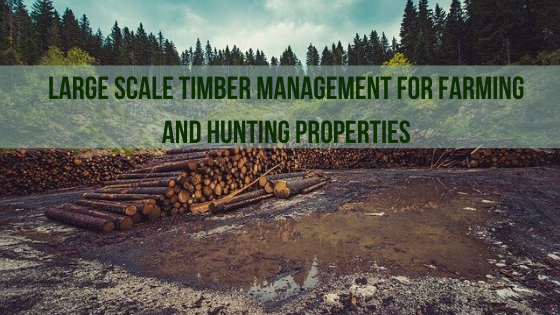What Is Timber Management?
If you own a farming or hunting property, timber management is essential to optimizing the fruits of your labor on the farm or on the hunt. Good timber management can make a world of a difference for your crops and animals. Good timber management needs to be double-checked every few years, and if you are going with a professional forester, you want one with knowledge on the location and environment you live in, i.e. if you are in Georgia, go for timber management in Georgia.
Timber management consists of various techniques and analyses that boost the inherent capabilities of your property for farming, habitat creation, whitetail deer, and other hunt animals. To begin managing timber, one examines their property and takes an inventory of their forest and timber. Whether your focus is on improving wildlife or improving tree and plant growth multiple steps can be followed to improve your woods. Making sure you have clear objectives and goals is a must before starting any project. There are multiple factors to examine that will change how you go about managing your land.
Timber Inventory and Property Evaluation
Soil is the first thing to consider when examining your land for timber. Soil can only handle so many trees before it will cause trouble so thinning is a must. Determine if thinning is something you want to add to your objectives. Thinning can improve soil quality, open up room for sunlight, and improve grass and plant growth under your trees.
Examine and determine any trees that are not healthy and leave room for the strongest trees to grow. Keep in mind these are not necessarily the biggest trees, just the healthiest. The weaker trees can be removed to make room for the stronger trees to grow. Think about this when determining where and how to go about thinning and managing your trees.
Think about your goals for space. Will you be harvesting, if so when? Is your main goal focused on timber income, wildlife, or plants? Based on these goals examine your property and look for factors that will aid in achieving these goals.
Forestry Factors To Consider
Every forest is different and there are many things to consider when thinking about your goals for your woodlands. There are many factors to consider when going about managing your timber. From age to past management to quality.
An important factor to consider is your woodland and trees’ age and species. Different species of trees may age at a different rate and therefore reach maturity earlier or later than others. The age of your trees will affect the timing of harvest as well as other factors so it is important to figure out an approximate age of your forest.
Looking into past management and harvesting practices of your land can also help you in taking care of your forests. Past practices can give you an idea of what to do, or even what not to do. Consider this when outlining your own practices.
Other factors to look out for include the topography and quality of the land. Where your woods are will affect much of your process so research practices for your local area. Consider whether your land has been burned or whether it has or will be grazed. Examine not only the tree species but other plant species that live on or around your trees. Many forests are infested with invasive species as well so figuring out local species to look out for is a must.
Many more factors can affect your woodlands growth and health so look into and learn everything you can about your specific property. Learning about your local area and the practices and techniques used near you is a great place to start. Professional foresters in your area should also be helpful for targeting your specific woods.
Invasive Species Control
One of the most important things to look out for in or around your property is invasive species. Catching and controlling these species early is essential to timber management. If ignored these invasive species can cause massive problems that are hard to fix once they are uncontrolled. Invasive species can impact tree health and growth, regeneration, and wildlife habitat. Invasive species and how to control for them will be different depending on where you live, but species control is important everywhere. Factors such as species, problem size, and area-specific factors such as soil, water, and precipitation, should all be examined when determining how to deal with invasive species. Depending on these factors invasive species control can be mechanical, chemical, or biological. Mechanical control involves physically pulling weeds, grubbing, or chopping the infected trees. Chemical control involves the use of herbicides. Biological control involves the use of animals such as insects or targeted grazing. The most used form of invasive species control will be mechanical or chemical. When controlling species with these methods make sure to take safety precautions as many invasive species can have spines or toxic substances, and herbicides can be harmful. Keep these ethical and health considerations in mind when dealing with invasive species. A very common invasive species is the Chinese Privet common around the state of Georgia.
Conclusion
Timber management, or the boosting of your land’s natural resources, can lead to better habitat creation, hunting, or farming when done right. Managing your property should always start with research about your area and local flora and fauna, and a careful examination of your land. Setting goals and compiling a plan of action to follow is at the core of timber management and if you are in Georgia or South Carolina and would love to talk with an expert forester and land realtor, come by Green Hill Land and Timber.
P.S: For more FREE online learning opportunities, Join the EAT FREE Community! Where you can make a little money, making the planet better!
Related Articles and Resources:
5 Tips on Growing Your Own Food In A Raised Bed Garden



